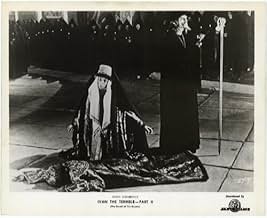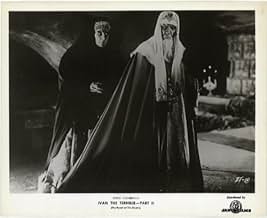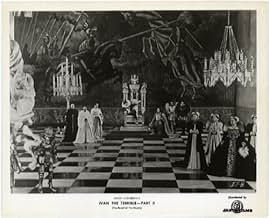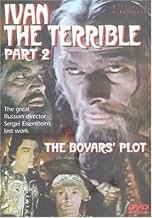Iwan, der Schreckliche II
Originaltitel: Ivan Groznyy. Skaz vtoroy: Boyarskiy zagovor
IMDb-BEWERTUNG
7,7/10
8463
IHRE BEWERTUNG
Als Ivan der Schreckliche mithilfe einer persönlichen Armee versucht, seine Macht zu festigen, planen seine politischen Gegner, die russischen Bojaren, den Zar zu ermorden.Als Ivan der Schreckliche mithilfe einer persönlichen Armee versucht, seine Macht zu festigen, planen seine politischen Gegner, die russischen Bojaren, den Zar zu ermorden.Als Ivan der Schreckliche mithilfe einer persönlichen Armee versucht, seine Macht zu festigen, planen seine politischen Gegner, die russischen Bojaren, den Zar zu ermorden.
- Regie
- Drehbuch
- Hauptbesetzung
- Auszeichnungen
- 1 Nominierung insgesamt
Vsevolod Pudovkin
- Nikolay the Fanatic
- (as V.I. Pudovkin)
Ada Voytsik
- Elena Glinskaya, Ivan's Mother
- (as Ada Vojtsik)
Aleksandr Rumnev
- The Stranger
- (Nicht genannt)
Semyon Timoshenko
- Kaspar von Oldenbock, Livonian ambassador
- (Nicht genannt)
Empfohlene Bewertungen
Ivan Grosnyy, Part II is the movie of my life; the Part I is also a very good film. It is the masterpiece of Sergei Eisenstein. Unfortunately we can never see the Part III of this meant to be trilogy. The performances (especially Nikolai Cherkasov), the photography, the wardrobe, the scenarios and the shots are the most beautiful I have ever seen in the history of film-making. However, it is necessary to watch the Part I first to understand the history. I suggest to all the people who like this genre of film to see another very good film of Sergey Eisenstein: Alexander Nevsky once again with Nikolai Cherkasov in the main role. I recommend to all the people who want to see these movies to by the Criterion DVD box set, which contains also first part and, Alexander Nevsky. Don't die without seeing these masterpieces.
While the first part of "Ivan the Terrible" is unique, stylized and powerful historical chronicle, second part is something more: poignant tragedy of authority. Since boyars poisoned Ivan's wife and his friends betrayed him, tsar remains in lonely. Oprichniki are only people he can trust. Ivan orders to kill some of boyars for instance, then Efrosinia Staricka (his aunt) sets plot against his life. One word gives atmosphere of this film: paranoia. Every character cares burden of fear - about his life, about his political business. Pervasive fear is delivered to us with unearthly dance of shadows, dramatic Prokofiev's score, haunting acting, poetic dialogs, monumental decorations and costumes. Everything looks very artificial but, paradoxically, not false; this film works with peerless emotional strength and brings as much true about authority as Shespeare's best works, being compatible to Maciavlelian theory of authority. There are only few films in history of cinema that so heavily consider problems of power (I'd mention "The Godfather, Part II" and Kurosawa's "Kagemusha" and "Ran" beside "Boyars Plot"). Don't miss. And if you decide to watch this film, I recommend: take great Criterion DVD box set which contains also first part and "Alexander Nevsky", another Eisenstein's sound masterpiece.
Ivan the Terrible marks the final stages of the cinema's greatest creative genius: SERGI EISENSTEIN. It is the work of a director, a supreme artist who never ceased in probing new boundires, striking out uncharted paths, and searching the outer limits of his art. In the work, Eisenstein has gone eons beyond his earlier methods of film creation and for the first time approaches a true synthesis of dance, music, poetry, painting, photography, architecture, and all other forms of aesthetic communication.
The trials and tribulations surrounding the production and distribution of Ivan have become legendary in there own right. The film drew sharp criticism from Stalin and Eisenstein was forced to publicly announce his ''formalist errors.'' Subsequently, the film was banned in Russia until 1958 and Eisenstein was ostracized for what many saw as a film full of ''excess.'' It took many years before the world would come to realize it is nothing short of his greatest masterpiece.
A true cinematic realization of the ever elusive ''total work of art.'' A concept that originated with the Ancient Greeks and was further formulated by Richard Wagner in his epic masterwork, ''THE RING CYCLE.'' The Gestanmueack or ''intragel work of art'' as Wagner called it was in essence the synthesizing of every artistic medium into a single polyphonic experience. In the 20th century Eisenstein saw Wagner's music dramas as predecessors of cinema; a cinema that synthesized elements of all of mankind's arts into a single majestic, visceral and emotional experience which could transform and transfix the spectator. Together with the world renowned composer, master Sergei Prokofiev, and his lifelong cinematographer Eduard Tisse, Eisenstein labored for years researching and planning out every camera angle, lighting scheme, musical note, costume, color palette, gesture, and perspective; until every scene in Ivan becomes an intricate and complex world of its own. A world where actors twist and bend their forms to the limits of the plastic frame, shadows conceal and light reveals, the musical notes flow with the rhythm and tempo of the visual image and in the famous banquet scene, colors are used by Eisenstein to delve into the psychological states of the character's mind and state of being. It becomes a universe composed so precisely and diligently that every frame is infused with hidden metaphorical and symbolic meanings, and serves to create the epitome of cinematic achievement.
Tragically, like Schubert's great ''Unfinished Symphony'' or the Venus di Milo, Eisenstein passed away before completing the final part of his epic masterwork. What remains of Ivan the Terrible will live forever as a testament not only to the genius of Sergei Eisenstein but also to his unparalleled contribution to the world culture of the 20th century.
The trials and tribulations surrounding the production and distribution of Ivan have become legendary in there own right. The film drew sharp criticism from Stalin and Eisenstein was forced to publicly announce his ''formalist errors.'' Subsequently, the film was banned in Russia until 1958 and Eisenstein was ostracized for what many saw as a film full of ''excess.'' It took many years before the world would come to realize it is nothing short of his greatest masterpiece.
A true cinematic realization of the ever elusive ''total work of art.'' A concept that originated with the Ancient Greeks and was further formulated by Richard Wagner in his epic masterwork, ''THE RING CYCLE.'' The Gestanmueack or ''intragel work of art'' as Wagner called it was in essence the synthesizing of every artistic medium into a single polyphonic experience. In the 20th century Eisenstein saw Wagner's music dramas as predecessors of cinema; a cinema that synthesized elements of all of mankind's arts into a single majestic, visceral and emotional experience which could transform and transfix the spectator. Together with the world renowned composer, master Sergei Prokofiev, and his lifelong cinematographer Eduard Tisse, Eisenstein labored for years researching and planning out every camera angle, lighting scheme, musical note, costume, color palette, gesture, and perspective; until every scene in Ivan becomes an intricate and complex world of its own. A world where actors twist and bend their forms to the limits of the plastic frame, shadows conceal and light reveals, the musical notes flow with the rhythm and tempo of the visual image and in the famous banquet scene, colors are used by Eisenstein to delve into the psychological states of the character's mind and state of being. It becomes a universe composed so precisely and diligently that every frame is infused with hidden metaphorical and symbolic meanings, and serves to create the epitome of cinematic achievement.
Tragically, like Schubert's great ''Unfinished Symphony'' or the Venus di Milo, Eisenstein passed away before completing the final part of his epic masterwork. What remains of Ivan the Terrible will live forever as a testament not only to the genius of Sergei Eisenstein but also to his unparalleled contribution to the world culture of the 20th century.
Ivan the Terrible Part II, the culmination of Eisenstein's career, is easily one of the most brilliant films of all time.
Nothing - repeat absolutely nothing - in this film is sub-par. The acting, especially the inhuman physical contortions of Nikolai Cherkasov as the Tsar himself, is uniformly excellent. As is to be expected from Eisenstein, the direction is perfect. Eisenstein's compositions create painterly tableaux that can be watched endlessly on pause (especially now that Criterion has issued both Ivans on DVD), allowing the audience to take in the full breadth of this man's genius. Additionally, unlike, for example, Alexander Nevsky or Strike, Ivan the Terrible Part II (and part I) benefits from a smoother pace and better editing, putting Eisenstein's theory of montage to its best use since Potemkin.
For me, however, what two key components of this film set it apart from its prequel and Eisenstein's earlier Potemkin and October.
Those components, as you can imagine, are its more pronounce political allegory and its color sequence towards the end.
Certainly October and Potemkin were highly politicized affairs, both celebrating the Communist victory in Russia. In Ivan the Terrible Part II (and to a lesser extent Part I), the audience bears witness to a moment of challenge wherein Eisenstein becomes critical of the course his country and its post-Lenin leaders have taken. As such, Ivan the Terrible becomes one of the bravest moments in film history and, for that alone, should be commended.
Brilliant as a political critique, the film also represents a dazzling demonstration of how color could be used in cinema. The colorized dance at the end of the film rivals and prefigures the technicolor explosion in Douglas Sirk's 1950s melodramas; furthermore, it reveals that color can be used to achieve specific effects. It does not have to mimic reality; rather it can be used artistically to enhance the mood and atmosphere of the film.
Taken as a whole, the two-part Ivan the Terrible is a masterpiece of Russian Cinema and should be required viewing for anyone with the slightest bit of interest in film. My preference lies with the second part, but both are fantastic moments in film history.
Nothing - repeat absolutely nothing - in this film is sub-par. The acting, especially the inhuman physical contortions of Nikolai Cherkasov as the Tsar himself, is uniformly excellent. As is to be expected from Eisenstein, the direction is perfect. Eisenstein's compositions create painterly tableaux that can be watched endlessly on pause (especially now that Criterion has issued both Ivans on DVD), allowing the audience to take in the full breadth of this man's genius. Additionally, unlike, for example, Alexander Nevsky or Strike, Ivan the Terrible Part II (and part I) benefits from a smoother pace and better editing, putting Eisenstein's theory of montage to its best use since Potemkin.
For me, however, what two key components of this film set it apart from its prequel and Eisenstein's earlier Potemkin and October.
Those components, as you can imagine, are its more pronounce political allegory and its color sequence towards the end.
Certainly October and Potemkin were highly politicized affairs, both celebrating the Communist victory in Russia. In Ivan the Terrible Part II (and to a lesser extent Part I), the audience bears witness to a moment of challenge wherein Eisenstein becomes critical of the course his country and its post-Lenin leaders have taken. As such, Ivan the Terrible becomes one of the bravest moments in film history and, for that alone, should be commended.
Brilliant as a political critique, the film also represents a dazzling demonstration of how color could be used in cinema. The colorized dance at the end of the film rivals and prefigures the technicolor explosion in Douglas Sirk's 1950s melodramas; furthermore, it reveals that color can be used to achieve specific effects. It does not have to mimic reality; rather it can be used artistically to enhance the mood and atmosphere of the film.
Taken as a whole, the two-part Ivan the Terrible is a masterpiece of Russian Cinema and should be required viewing for anyone with the slightest bit of interest in film. My preference lies with the second part, but both are fantastic moments in film history.
10rnair
This space can't afford me the kind of gargantuan platform needed to speak on Eisenstein's masterwork (both parts) with the sort of attention to detail and passion that the director brings to the story of the Russian tsar. This is the rarest of films that stands as a testament to how cinema can extend beyond an entertainment and exist as a singular work of art and a document that works to expand our knowledge of the human condition. Every frame is rich, every scene speaks far more than any written line or action. The production is a phenomenal achievement in the absolute totality of the collaborative effort; the actors, the set, the cinematography, the soundtrack - every facet of the film-making process has worked to create a seamless connection. While the approach of the actors, the lighting and the choices of camera angles frustrate our standard ideas of what a movie should look and feel like, there is a design here; it is precise and it is brilliant. This is a film for those viewers who, as Eisenstein famously said, read (not just watched) the images on the screen. One of the two or three true masterworks in the history of movies.
Wusstest du schon
- WissenswertesThis film was withheld by Soviet authorities by order of Joseph Stalin, since this film, dealing with Ivan's slide into madness and the tyranny of the Oprichnina, did not properly mythologize Ivan IV Grozny to Stalin's satisfaction. It was not finally released until 10 years after the deaths of director Sergei Eisenstein and Stalin.
- PatzerIn the movie young Ivan IV is making a contract with the Livonian Brothers of the Sword. However it didn't exist since the 7th June 1238, almost 300 years before Ivan was born.
- Zitate
Czar Ivan IV: From now on I will become the one you call me. I will become terrible.
- Crazy CreditsThe main cast and their roles is read by the narrator with accompanied footage.
- VerbindungenFeatured in The Secret Life of Sergei Eisenstein (1987)
Top-Auswahl
Melde dich zum Bewerten an und greife auf die Watchlist für personalisierte Empfehlungen zu.
Details
- Erscheinungsdatum
- Herkunftsland
- Sprache
- Auch bekannt als
- Ivan the Terrible, Part II: The Boyars' Plot
- Drehorte
- Produktionsfirmen
- Weitere beteiligte Unternehmen bei IMDbPro anzeigen
Box Office
- Weltweiter Bruttoertrag
- 1.655 $
- Laufzeit1 Stunde 28 Minuten
- Farbe
- Sound-Mix
- Seitenverhältnis
- 1.37 : 1
Zu dieser Seite beitragen
Bearbeitung vorschlagen oder fehlenden Inhalt hinzufügen

Oberste Lücke
By what name was Iwan, der Schreckliche II (1946) officially released in India in English?
Antwort
































